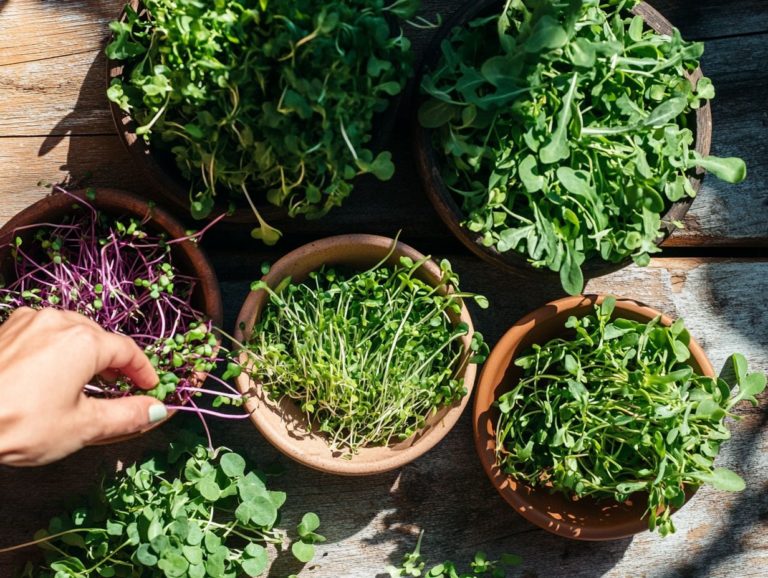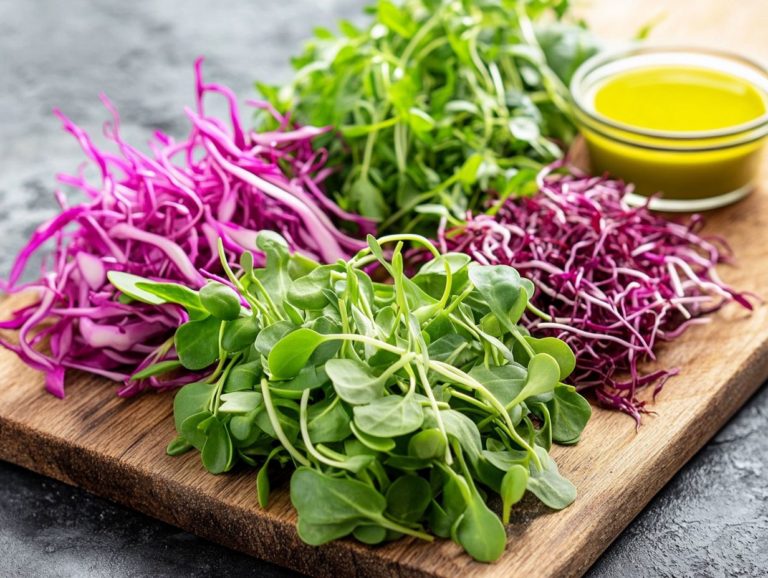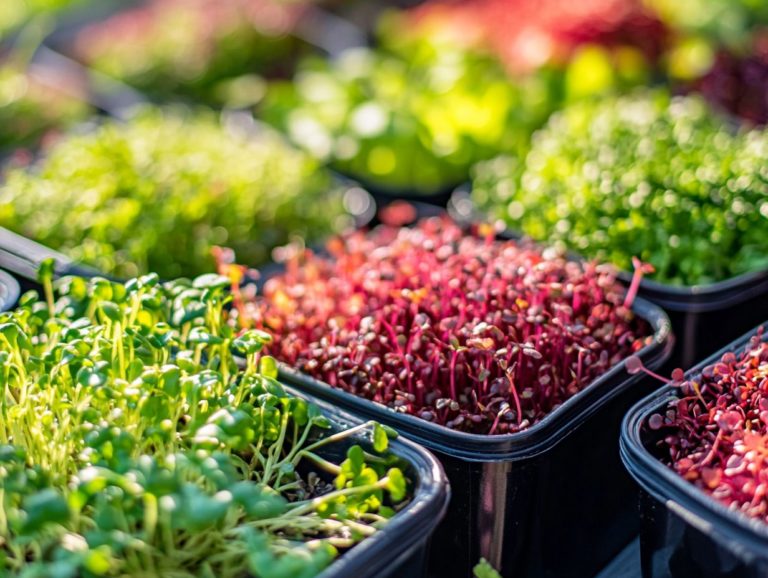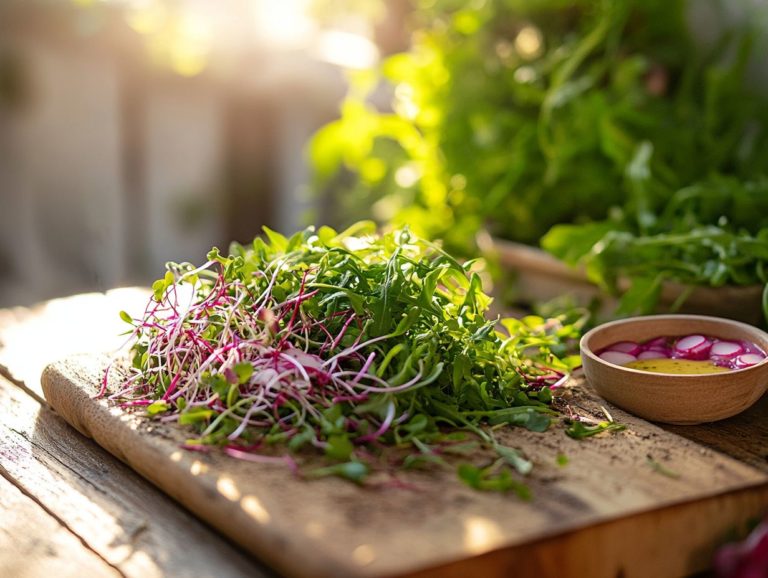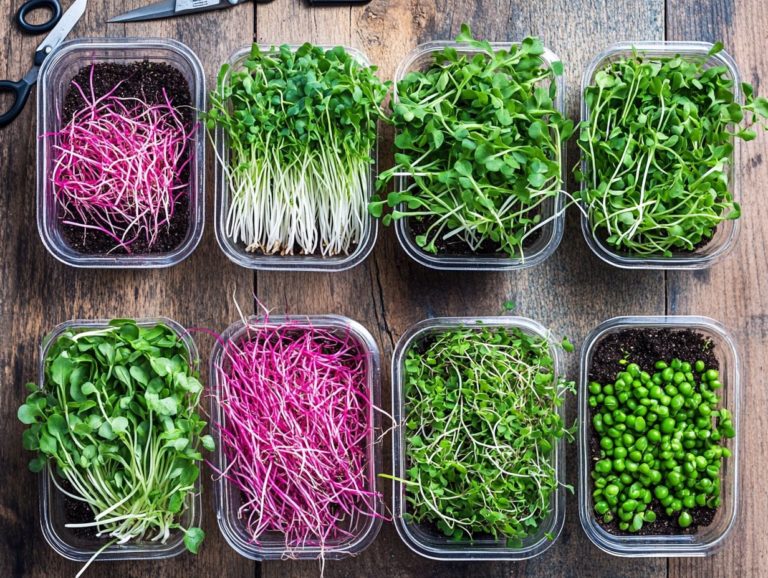Microgreens: Tiny Greens, Big Benefits
Microgreens are small yet powerful plants brimming with nutrition. They are a sought-after choice for those who prioritize health and culinary excellence, especially in the culinary arts.
This article explores microgreens. It highlights their nutritional value compared to mature greens and the health benefits they provide, such as improving digestion and managing weight.
You’ll find guidance on growing microgreens, harvesting, and seamlessly incorporating these vibrant greens into your meals. Start your microgreens garden today!
Discover expert tips for selecting and storing them to maintain peak freshness while maximizing their health-supporting components.
Embark on this flavorful journey into the realm of microgreens, a vibrant addition to your home gardening efforts!
Contents
Key Takeaways:
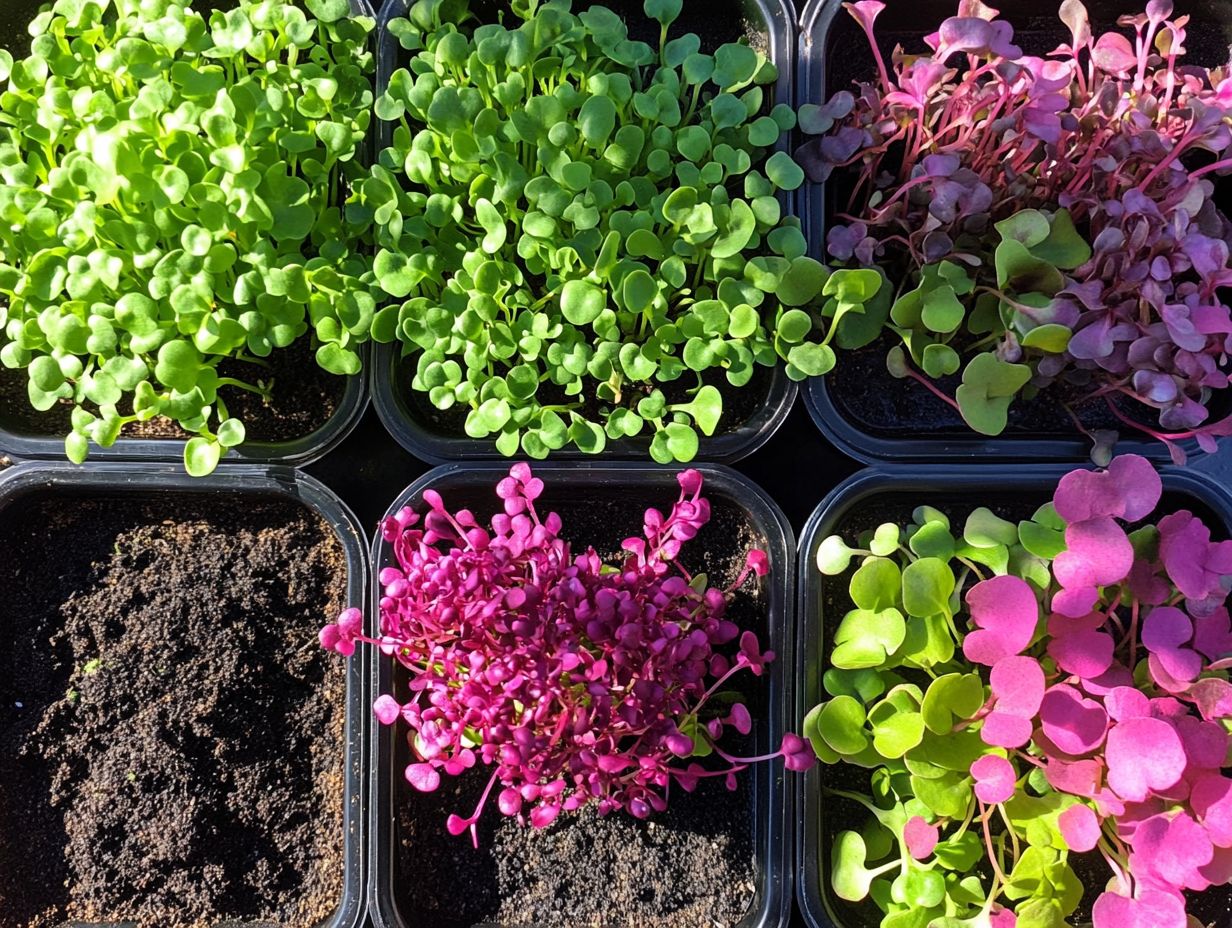
- Microgreens are young, edible greens packed with nutrients that you can grow at home.
- These tiny greens have a higher concentration of vitamins and minerals, including vitamin K and vitamin C, compared to their mature counterparts.
- Incorporating microgreens into your diet can help boost immunity, reduce inflammation, and potentially prevent chronic diseases like heart disease and cancer.
What are Microgreens?
Microgreens are delightful little plants you can grow at home, such as amaranth and broccoli, harvested just as their first true leaves emerge. They encompass a diverse range of vegetables and herbs, with popular options like amaranth and broccoli microgreens leading the charge.
These vibrant seedlings are celebrated for their intense flavors and stunning colors. They also pack a remarkable nutritional punch, making them a cherished favorite in home gardening and the culinary world alike.
Definition and Characteristics
Microgreens are young seedlings of edible vegetables and herbs. They are distinguished by their vibrant colors and intense flavors. Often harvested when they stand just a few inches tall, they are easy to grow.
These tiny plants typically hit the market only two to three weeks after germination, allowing for a quick harvest that is profoundly impactful. One of their most enticing features is their remarkable nutrient density; they often contain higher concentrations of vitamins, minerals, and antioxidants compared to fully matured counterparts.
Their culinary charm is undeniable; just a sprinkle can elevate any dish, adding both visual allure and delicious flavor. Chefs and home cooks alike hold these versatile greens in high regard for their ability to enhance everything from salads to sandos, making them a delightful addition to both everyday meals and gourmet creations.
Nutritional Value of Microgreens
Microgreens are true nutrient powerhouses, delivering an impressive concentration of vitamins and minerals in a petite serving. They offer remarkable health benefits, boasting elevated levels of vitamin K, vitamin C, and essential dietary fiber.
Incorporating microgreens into your diet can elevate your nutritional game significantly, providing an energy boost and improving digestion. Dive into the world of microgreens and discover why microgreens are superfoods you need to transform your meals today!
Comparison to Mature Greens
Microgreens often outperform mature greens. Studies show they have higher concentrations of vitamins, minerals, and antioxidants, making them an invaluable addition to your healthy diet. This is especially true for those interested in the health benefits of nutrient powerhouses.
These tiny greens burst with robust flavors and vibrant colors. They can contain up to five times more vitamin C, making them an excellent choice for anyone looking to reduce LDL cholesterol. They are also rich in essential nutrients like vitamin K, crucial for bone health and blood pressure regulation, and vitamin E, known for its antioxidant properties. Incorporating the benefits of eating microgreens daily can further enhance your diet.
You’ll discover significant amounts of minerals like calcium, magnesium, and iron in microgreens. By incorporating these nutrient-dense varieties into your meals, you can elevate your nutritional intake while enjoying a delightful explosion of flavor in your culinary endeavors. To learn more about their advantages, check out the health benefits of microgreens explained.
Health Benefits of Microgreens
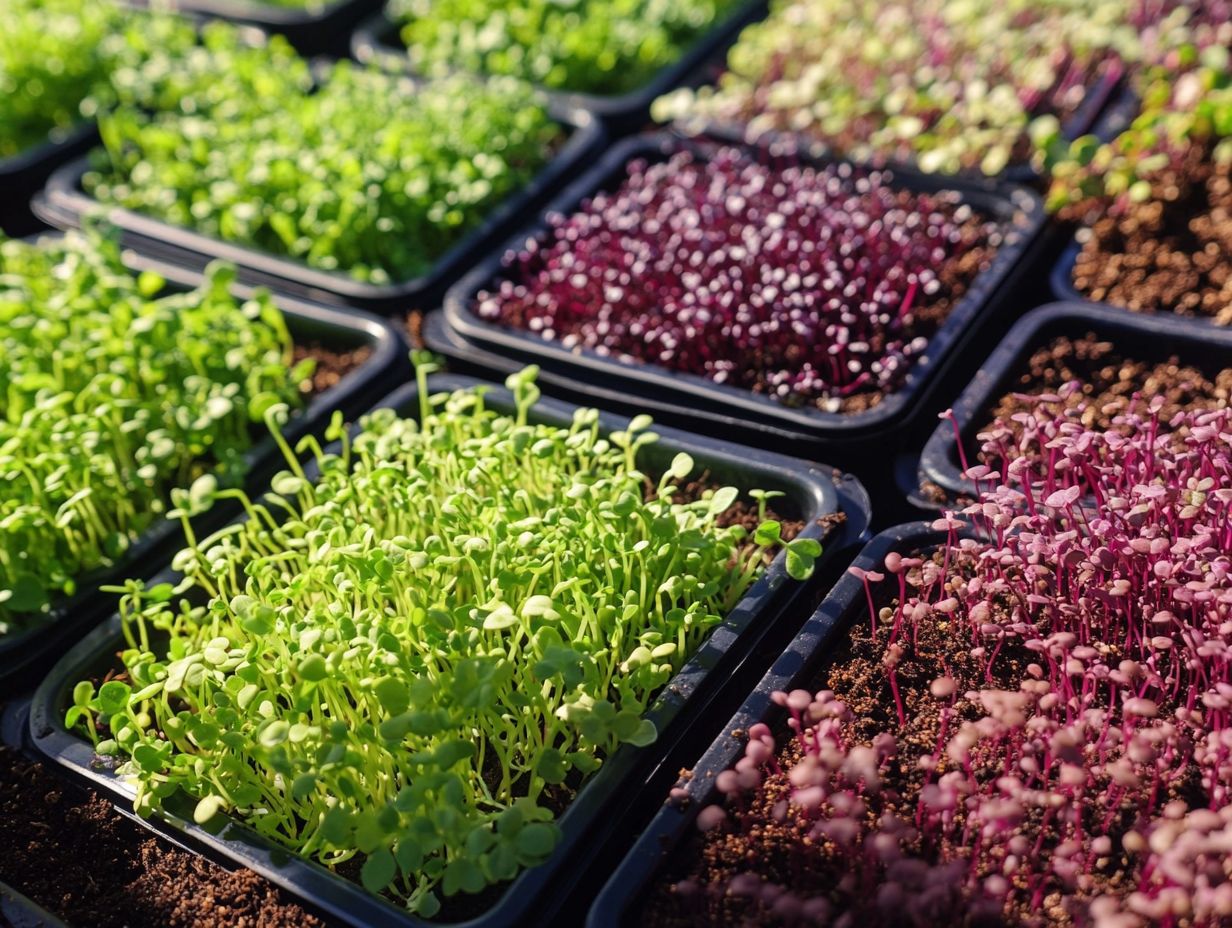
The health benefits of microgreens are compelling. Research highlights their positive effects on gut health and immune function. They are rich in antioxidants and contribute to gut health, lowering blood pressure, and reducing LDL cholesterol levels. This makes them essential in a healthy diet.
Incorporating microgreens into your meals enhances overall wellness through their prebiotic material and other health-supporting components, and exploring the benefits of growing diverse microgreen varieties can further enrich your diet.
Antioxidant and Anti-inflammatory Properties
Microgreens are a powerhouse of antioxidants and anti-inflammatory properties. They help combat oxidative stress, which is when harmful free radicals damage your cells. This can potentially ward off chronic diseases like heart disease and cancer, enhancing your nutritional profile.
These tiny plants, often harvested right after their first leaves sprout, are rich in essential nutrients, including various vitamins and minerals. Varieties such as broccoli and kale microgreens are especially high in sulforaphane, a potent compound with inflammation-reducing effects that can lower the risk of chronic diseases. Additionally, exploring the benefits of growing microgreens vertically can enhance your gardening experience and yield.
Radish microgreens are packed with antioxidants like vitamin C, boosting your body s defenses while providing a delicious flavor. The flavonoids in these greens play a key role in neutralizing free radicals, which supports cellular health and overall immune function.
Adding a variety of microgreens to your meals promotes overall wellness, aids digestion, and lowers the risk of health issues.
Other Potential Health Benefits
Microgreens are invaluable allies for your gut health, energy production, and immune function. They are a vital addition to your diet.
These tiny powerhouses are rich in essential vitamins and minerals that enhance healthy digestion by fostering the growth of beneficial gut bacteria. This can also aid in weight management. Improved gut health not only prevents digestive issues but also boosts nutrient absorption, keeping your energy levels high throughout the day.
Microgreens can strengthen your immune system, providing a protective barrier against common ailments and supporting overall health. By including these vibrant greens in your meals, you can build a stronger, more resilient body, ready to tackle the challenges of daily life. Check out the top microgreen varieties for health enthusiasts to enhance your diet.
Growing and Harvesting Microgreens
Growing microgreens is both accessible and rewarding. They are easy to cultivate, requiring minimal space and resources, making them perfect for your home and a great gateway into the culinary world.
Whether you choose soil or hydroponic methods, these little greens thrive effortlessly. You can enjoy a quick harvest typically within just two weeks from sowing the seeds allowing you to savor your home-grown greens sooner.
Start your own microgreen garden today and taste the difference!
Step-by-Step Guide
This step-by-step guide to growing microgreens lays out a straightforward process, taking you from seed selection to savoring your home-grown greens. Enjoy delicious flavors and nutrient density at home! It s an accessible option for anyone looking to dip their toes into gardening.
- Begin with the all-important task of selecting your seeds. You’ll find an array of choices, like basil, radish, or kale. Each offers distinct flavors and nutritional perks, contributing to their versatility in the kitchen.
- Once you’ve picked the perfect seeds, prepare a shallow tray filled with good soil to set the stage for vibrant growth. After evenly sowing the seeds, mist them gently with water to encourage moisture retention without overwhelming them.
- Next, place your tray in a warm, well-lit spot ideally with indirect sunlight to stimulate germination. Remember, regular watering is key. Keep the soil consistently moist but not soggy until your greens are ready for harvest, usually within two weeks.
Follow these simple steps to enjoy delicious, nutrient-packed microgreens. They can enrich your meals and boost your health. For more information, check out the benefits of indoor microgreen growing.
Incorporating Microgreens into Your Diet

Incorporating microgreens into your diet offers a delightful opportunity to elevate your meals and explore various cooking methods. Their exquisite flavors and vibrant colors transform dishes, making them a versatile ingredient suitable for a range of cooking methods and recipes, including salads and smoothies.
Recipe Ideas and Tips
Microgreens can elevate a wide range of dishes, from salads to smoothies. They infuse each creation with intense flavors and added nutrients, showcasing their versatility in the kitchen.
These petite greens, like radish and arugula, add a peppery or earthy essence that can transform an ordinary meal into something extraordinary. They enhance the overall nutritional profile.
Consider incorporating pea shoots into a fresh spring salad or blending sunflower microgreens into a creamy smoothie. The delightful contrasts in taste and texture will surprise and please your palate!
You can also sprinkle delicate basil or cilantro microgreens atop grilled meats or fish. This finishing touch enhances flavor and offers health benefits while elevating visual appeal.
By experimenting with microgreens in various culinary contexts, you not only boost the nutritional profile of your dishes but also unleash your creativity in the kitchen.
Buying and Storing Microgreens
When purchasing microgreens, choosing fresh and vibrant varieties is crucial for achieving the best health benefits. This selection guarantees that you maximize the health-supporting nutrients and flavors in your meals.
How to Choose and Keep Fresh
To truly savor the best flavor and nutritional value when purchasing microgreens, seek those that are vibrant, crisp, and devoid of any wilting or discoloration. Microgreens, especially amaranth microgreens and broccoli, are tiny plants that pack a powerful nutritional punch.
A strong aroma often signals freshness and potency. Opting for microgreens from reputable sources or local farmers’ markets will boost your chances of acquiring a superior product, especially if you choose from the top 10 microgreens for nutritional boost.
After selecting the freshest microgreens, proper storage becomes paramount for preserving their exquisite taste and nutritional benefits. Store them in a sealed container in the refrigerator, ideally wrapped in a damp paper towel to maintain moisture without creating sogginess.
Consuming these delicate greens shortly after purchase not only elevates your meals but also ensures you maximize their health benefits.
Frequently Asked Questions
Try growing your own microgreens today for a fresh flavor boost in your meals!
What are microgreens and what are their benefits?
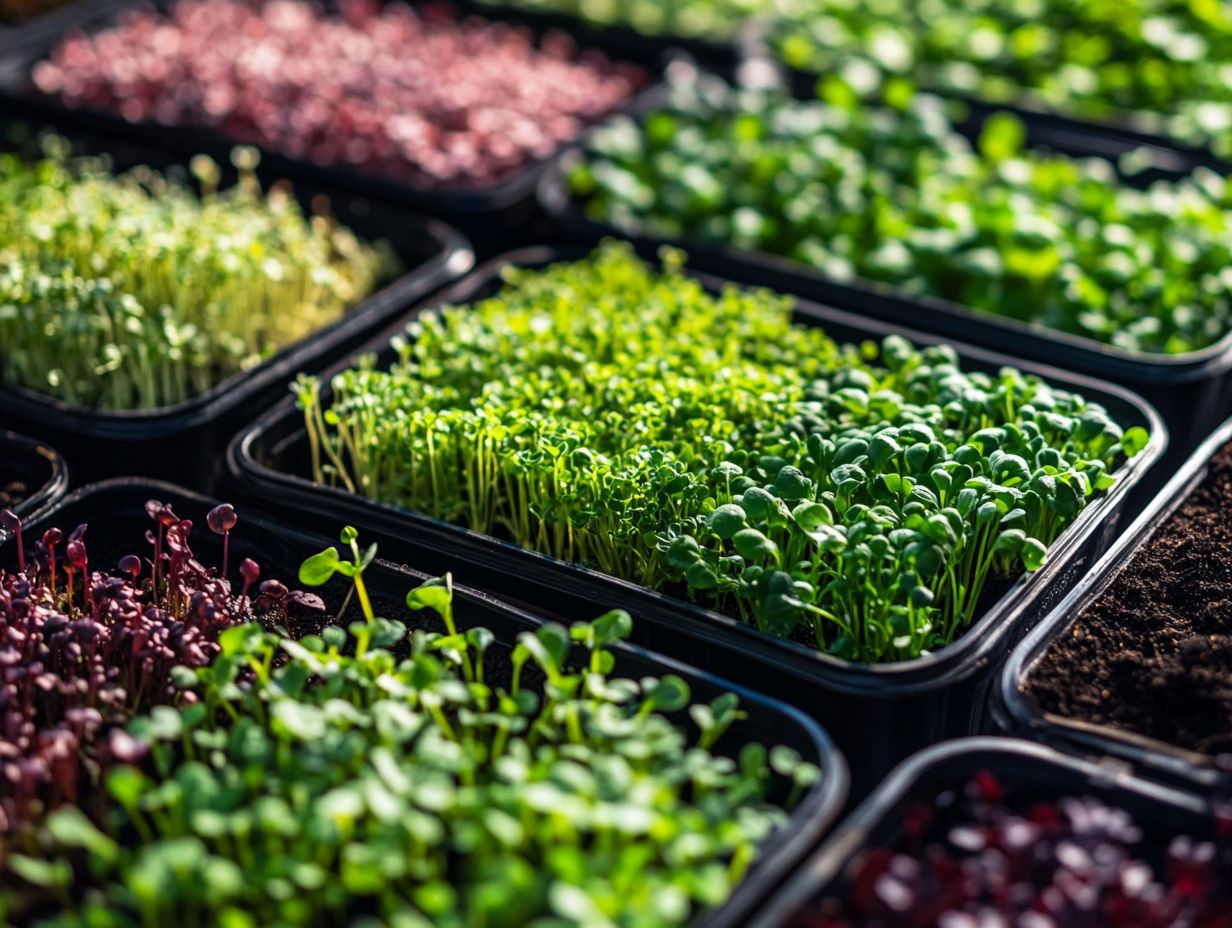
Microgreens are young, edible greens harvested after the first set of real leaves develop. They are packed with nutrients and offer a range of health benefits, including improved digestion and increased energy.
These tiny greens can also enhance immune function, making them a great addition to your diet.
Why are microgreens considered a superfood?
Microgreens are called a superfood because they are incredibly nutrient-dense. They can contain up to 40 times more vitamins and minerals than their mature counterparts.
How do microgreens differ from sprouts?
Microgreens and sprouts are often confused, but they are quite different. Sprouts are germinated seeds grown in water and eaten whole, while microgreens are grown in soil and harvested when their first true leaves appear.
Can microgreens be grown at home?
Absolutely! Growing microgreens at home is fun and super easy.
All you need is a shallow container, some potting soil, and a light source to get started.
How do I incorporate microgreens into my meals?
Microgreens can be added to a variety of dishes to boost flavor and nutrition. Use them as a garnish, toss them into salads, stir them into soups or omelets, blend them into smoothies, or top sandwiches and pizzas with them.
Are there any concerns or precautions to keep in mind when consuming microgreens?
While generally safe to eat, it’s important to wash microgreens thoroughly to remove any potential bacteria or contaminants. People with allergies to certain plants or those taking blood thinners should consult with a healthcare professional before consuming them.

